Operational Improvements to Reduce the Climate Impact of Aviation—A Comparative Study from EU Project ClimOP
Abstract
:1. Introduction
- Trajectory optimization including in-flight measures that reduce the climate effect along trajectories by re-routing or improving procedures without changing the investigated flight network itself. The climate impact can directly be related to one individual mission. Exemplary measures are weather-optimized flight planning [21,22], climate-optimized trajectories [17,23,24], flying at reduced altitudes and speeds [14,25,26], direct or wind-optimal routing [21,27], continuous climb and descent operations [21,28], and routing optimization for contrail avoidance [16,29].
- Climate-optimized operation of airline networks comprising in-flight measures that affect the network for example by changes in the network flight schedule, where reduction in the climate impact is not directly related to one individual mission. This includes approaches such as Formation flight [19], Intermediate Stop Operations (ISO) [15,30] and climate-aware network design and planning [31,32,33], e.g., by merging or separating flights, reassigning aircraft, frequencies, and creating optimal hub-and-spokes or point-to-point operations.
- Operational measures on-ground being implemented at the airport both air- and land-side including, for instance, the upgrade of existing airport infrastructure according to energy-efficiency criteria [34], sustainable taxi operations, e.g., by switching to single-engine, electric, or hybrid solutions [21,35,36], electrification of ground vehicles [37,38], or producing renewable energy at airports [39].
2. Comparative Method
2.1. Operational Improvements to Be Compared
- Mitigation potential of the OI to significantly reduce the climate impact of aviation in terms of CO and non-CO emissions.
- Scientific relevance, i.e., the OI is discussed and considered promising in the specialized literature on climate change and aviation.
- Technological readiness, which directly affects the timescale of implementation in everyday operations and a low cost/benefit ratio of the implementation to facilitate the measures realization.
- Coverage of all areas of operations, namely the airport operations, the aircraft ground operations, and the aircraft operations at network and trajectory levels.
- Modeling feasibility, capability and expertise of involved parties of the project including the ability to model changes of the relevant operations, and to quantify the impact on the climate and the stakeholders.
2.2. Selected Metrics for Comparison
2.3. Scaling Approach
2.3.1. Comparing Climate Mitigation Potentials for Different In-Flight OIs
2.3.2. Comparing Climate Mitigation Potentials for Different On-Ground OIs
2.4. Data and Application of the Scaling Approaches
2.4.1. Application for In-Flight-Related OIs
2.4.2. Application for Ground-Related OIs
- SETX: We estimate the taxi times at the different airports based on average taxi times at Europe’s most frequented airports for one representative aircraft type.
- ELEC: We assume an equal distribution of ground fleet vehicle categories regarding vehicle sizes and mileages, while the fleet size itself is expected to scale with the annual air traffic at the considered airports.
- INFR: We incorporate the climate zones corresponding to the airport location as this is expected to significantly influence the efficacy of the selected energy-efficiency measures.
3. Results: Comparing Different Operational Mitigation Measures in Aviation
3.1. Mitigation Potential from Assessment of Individual OIs
3.1.1. Individual Mitigation Potential of Trajectory-Related OIs
3.1.2. Individual Mitigation Potential of Network-Related OIs
3.1.3. Individual Mitigation Potential of Ground-Related OIs
3.2. Generalization and Comparison within Measure Types
3.2.1. Comparison of Trajectory-Related OIs
3.2.2. Comparison of Network-Related OIs
3.2.3. Comparison of Ground-Related OIs
3.3. Comparison across Measure Types
4. Discussion
5. Outlook and Conclusions
Author Contributions
Funding
Institutional Review Board Statement
Informed Consent Statement
Data Availability Statement
Acknowledgments
Conflicts of Interest
Abbreviations
| aCCF | Algorithmic climate change function |
| ANSP | Air navigation service provider |
| ASHRAE | American Society of Heating, Refrigerating and Air-Conditioning Engineers |
| ASK | Available seat kilometers |
| ATR | Average temperature response |
| ATR20 | Average temperature response over 20 years |
| ATR100 | Average temperature response over 100 years |
| ATC | Air traffic control |
| ATS | Air traffic service |
| BADA4 | Base of aircraft data v.4.2 |
| BAU | Business-as-usual |
| CiC | Contrail-induced cirrus |
| CLIM | Operational improvement of climate-optimized flight planning |
| ClimOP | Climate assessment of innovative mitigation strategies towards |
| operational improvements in aviation | |
| CO | Carbon dioxide |
| CO-Eq | CO equivalents |
| CORSIA | Carbon Offsetting and Reduction Scheme for International Aviation |
| DLR | Deutsches Zentrum für Luft- und Raumfahrt e.V. (German Aerospace Centre) |
| DOC | Direct operating cost |
| ECAC | European Civil Aviation Conference |
| ECMWF | European Centre for Medium-Range Weather Forecasts |
| ELEC | Operational improvement of electrification of ground vehicles |
| ETS | European Union Emissions Trading System |
| F-ATR | Future-emission-scenario-based ATR |
| FABEC | Functional Airspace Block Europe Central |
| FREE | Operational improvement of free routing |
| GHG | Greenhouse gas |
| GPU | Ground power unit |
| GSE | Ground support equipment |
| GTP | Global temperature potential |
| GWP | Global warming potential |
| H&S | Hub-and-spoke network |
| HO | Water, water vapor |
| ICAO | International Civil Aviation Organization |
| INFR | Operational improvement of upgrade of airport infrastructure |
| ISO | Intermediate stop operations |
| ISOC | Operational improvements of climate-optimized intermediate stop operations |
| ITU | Istanbul Technical University |
| LCC | Low-cost carriers |
| LTO | Landing–take-off |
| KPI | Key performance indicator |
| LOSL | Operational improvement of reduced cruise altitudes and speed |
| MXP | Milan Malpensa airport |
| NCEP | National Centers for Environmental Prediction |
| NETW | Operational improvement of network optimization |
| NO | Nitrogen oxides |
| OI | Operational improvement |
| OD | Origin–destination |
| RedEmP | Reduced Emission Profiles |
| RF | Radiative forcing |
| SETX | Operational improvement of sustainable taxi operations |
| TCM | Trajectory Calculation Module |
| TGT | Trajectory Generation Tool |
| TOM | Trajectory Optimization Module |
| TOT | Trajectory Optimization Tool |
| WIND | Operational improvement of wind-optimal flight planning |
Appendix A. Assessment of Individual OIs
Appendix A.1. Trajectory-Related Measures
Appendix A.1.1. Assessment Method
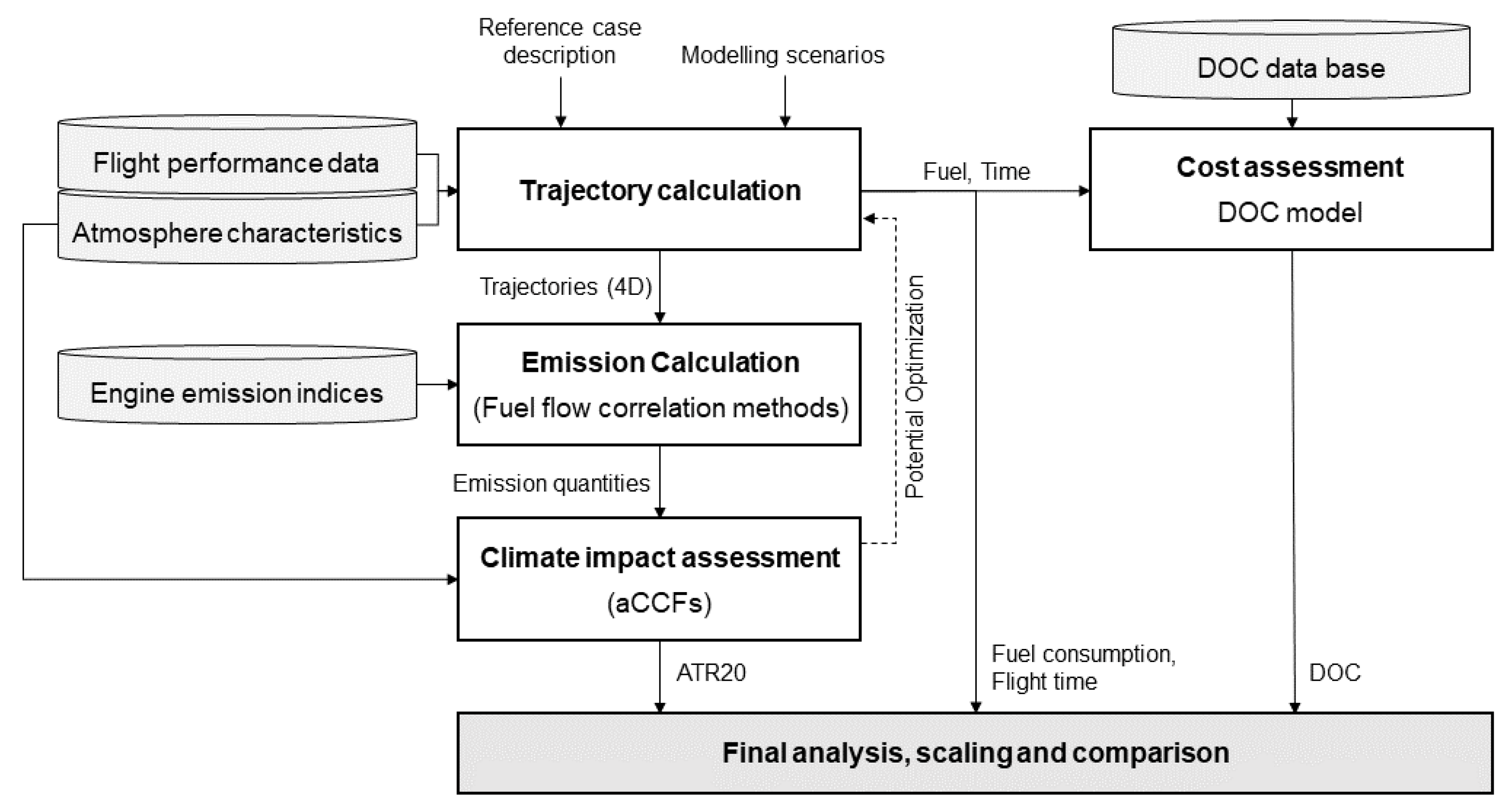
- An implementation of the OI LOSL was modeled by considering combinations of altitude shifts of 2000, 4000, and 6000 ft and speed reductions of 0, 5, and 10% in comparison to the reference case. The optimized set-up is selected based on minimum ATR20. The reference case was defined by a sample of flights on four representative days performed with two selected representative wide-body aircraft types on missions from or to the ECAC area.
- The OIs FREE and WIND have been implemented by focusing on one high-complexity en-route airspace in the ECAC area, namely EDUU, and using the flight plans and weather information on a representative winter day in 2018. Three case studies of OI implementation are evaluated to explore the mitigation potentials of the concept with different objective functions (i.e., the shortest path for FREE, the weighted sum of travel duration and fuel consumption, or prioritizing decreasing NO emissions by also considering fuel consumption and travel duration for WIND).
- The CLIM OI applies aCCFs to describe the climate impact of CO and non-CO effects in a set of trajectory optimization experiments. Therefore, the climate mitigation potential with respect to ATR20 was determined by avoiding climate-sensitive regions associated with different fuel penalties. Four city pairs with departures from the ECAC area were selected for the representative winter day.
Appendix A.1.2. Results
Appendix A.2. Network-Related Measures
| Climate Mitigation Potential | Change in DOC | Limitations | |
|---|---|---|---|
| LOSL [45,70] |
|
|
|
| FREE [47] | −24.4% on 11 December 2018 | −4.3% on 11 December 2018 |
|
| WIND [47] |
|
|
|
| CLIM [48] |
|
|
|
Appendix A.2.1. Assessment Method

Appendix A.2.2. Results
| Change in ATR100 | Change in Profit/DOC | Limitations | |
|---|---|---|---|
| NETW [31,71] |
| Profit decrease by
|
|
| ISOC [20] | −40.3% | DOC increase by 20.9% |
|
Appendix A.3. Ground-Related Measures
Appendix A.3.1. Assessment Approach
Appendix A.3.2. Results
| Emissions | Fuel | Energy | ATR100 | Limitations | |
|---|---|---|---|---|---|
| SETX |
| −54.2% | Inf | −54.4% |
|
| ELEC |
| −100% | Inf | −84.1% |
|
| INFR |
| - | −18.5% | −21.0% |
|
Appendix B. Validation of In-Flight Scaling Approach
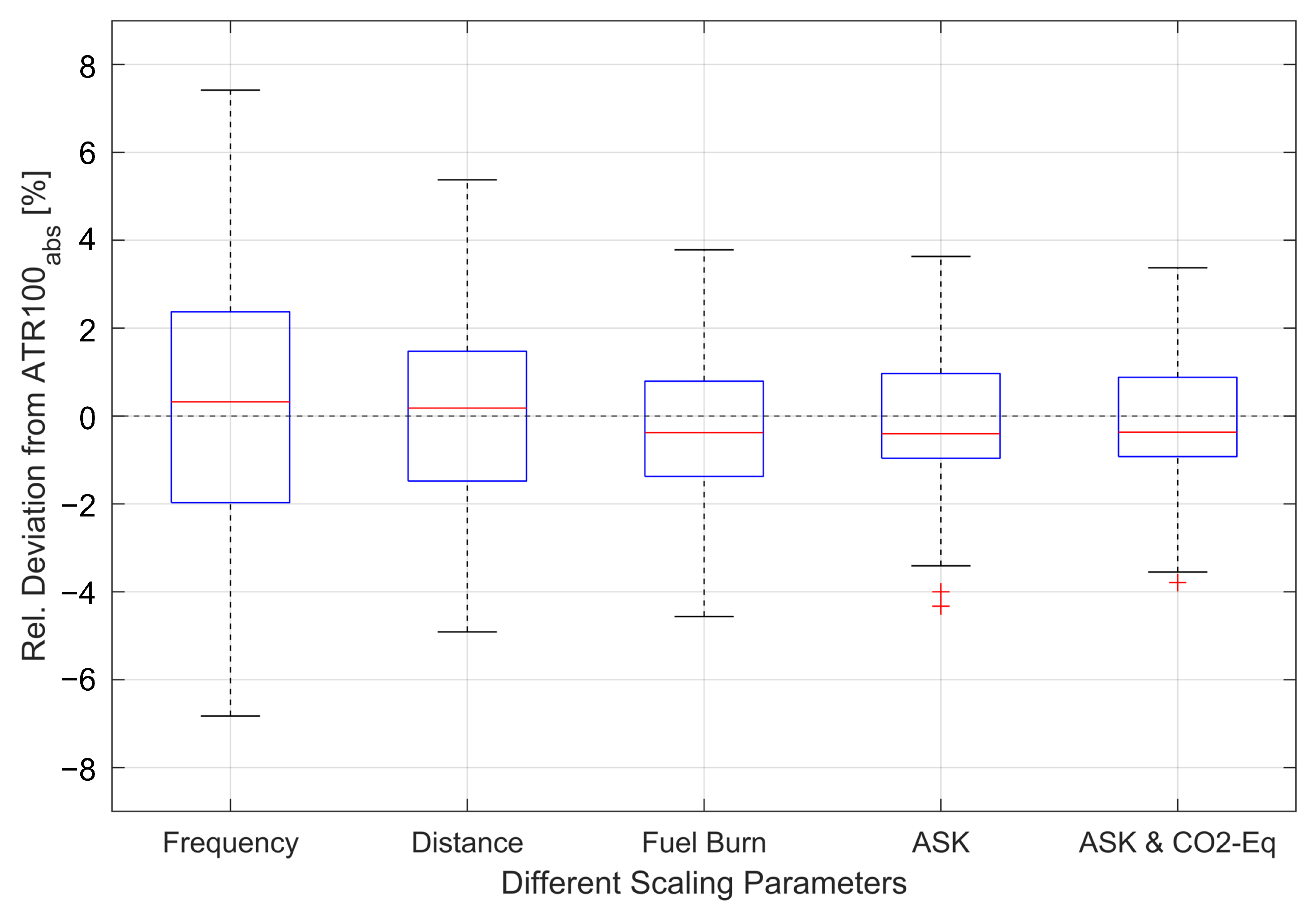
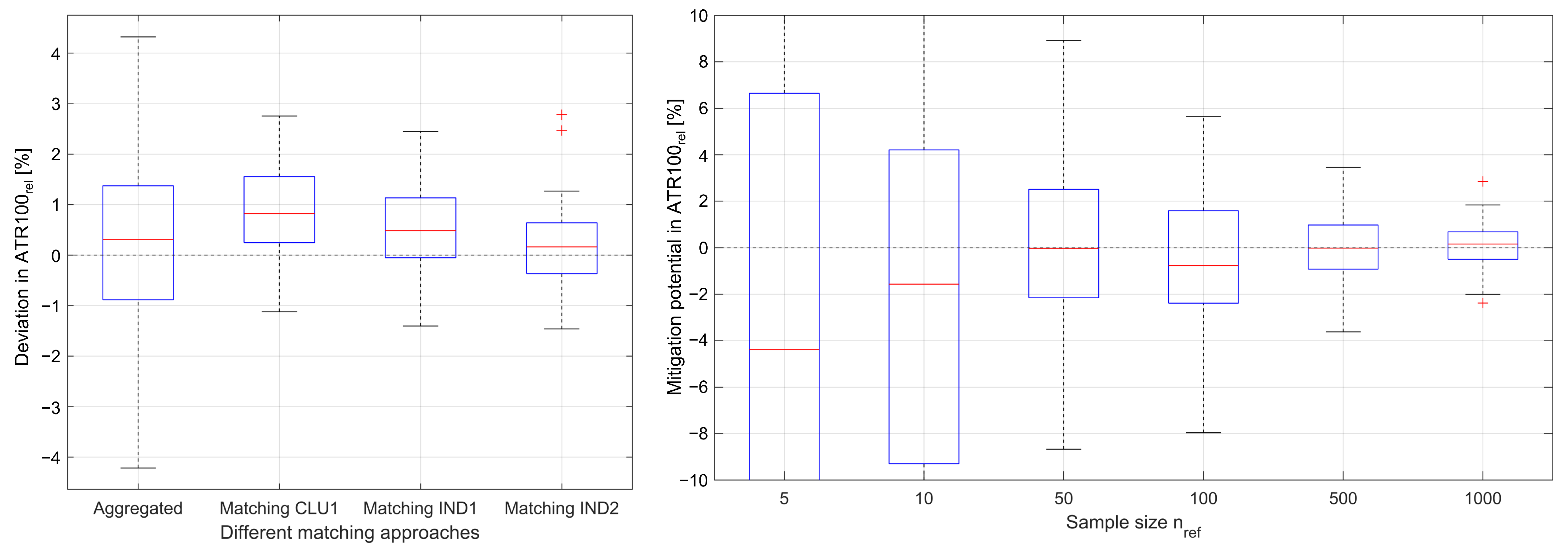
References
- Edenhofer, O.; Pichs-Madruga, R.; Sokona, Y.; Seyboth, K.; Arvizu, D.; Bruckner, T.; Christensen, J.M.; Devarnay, J.M.; Faaij, A.; Fischedick, M.; et al. Summary for Policymakers. In IPCC Special Report on Renewable Energy Sources and Climate Change Mitigation; Edenhofer, O., Pichs-Madruga, R., Sokona, Y., Seyboth, K., Matschoss, P., Kadner, S., Zwickel, T., Eickemeier, P., Hansen, G., Schlömer, S., et al., Eds.; Cambridge University Press: Cambridge, UK, 2011. [Google Scholar]
- Fuglesvedt, J.; Berntsen, T.; Godal, O.; Sausen, R.; Shine, K.; Skodvin, T. Metrics of Climate Change: Assessing Radiative Forcing and Emission Indices. Clim. Chang. 2003, 58, 267–331. [Google Scholar] [CrossRef]
- Lee, D.; Fahey, D.; Skowron, A.; Allen, M.; Burkhardt, U.; Chen, Q.; Doherty, S.; Freeman, S.; Forster, P.; Fuglestvedt, J.; et al. The contribution of global aviation to anthropogenic climate forcing for 2000 to 2018. Atmos. Environ. 2021, 244, 117834. [Google Scholar] [CrossRef] [PubMed]
- Lee, D.; Pitari, G.; Grewe, V.; Gierens, K.; Penner, J.; Petzold, A.; Prather, M.; Schumann, U.; Bais, A.; Berntsen, T.; et al. Transport impacts on atmosphere and climate: Aviation. Atmos. Environ. 2010, 44, 4678–4734. [Google Scholar] [CrossRef] [PubMed] [Green Version]
- Aviation Benefits Beyond Borders (ATAG). Waypoint 2050. 2021. Available online: https://aviationbenefits.org/environmental-efficiency/climate-action/waypoint-2050/ (accessed on 5 October 2022).
- European Commission. Europe’s Vision for Sustainable Aviation—Report of the Advisory Council for Aviation Research and Innovation in Europe (ACARE). 2022. Available online: https://www.acare4europe.org/wp-content/uploads/2022/06/20220815_Fly-the-green-deal_LR-1.pdf (accessed on 28 June 2023).
- International air transport association (IATA). Net-Zero Carbon Emissions by 2050. Press Release no. 66. Available online: https://www.iata.org/en/pressroom/pressroom-archive/2021-releases/2021-10-04-03/ (accessed on 7 July 2022).
- Grewe, V.; Gangoli Rao, A.; Grönstedt, T.; Xisto, C.; Linke, F.; Melkert, J.; Middel, J.; Ohlenforst, B.; Blakey, S.; Christie, S.; et al. Evaluating the climate impact of aviation emission scenarios towards the Paris agreement including COVID-19 effects. Nat. Commun. 2021, 12, 3841. [Google Scholar] [CrossRef]
- Singh, V.; Sharma, S.K. Fuel consumption optimization in air transport: A review, classification, critique, simple meta-analysis, and future research implications. Eur. Transp. Res. Rev. 2015, 7, 12. [Google Scholar] [CrossRef]
- Green, J. Air Travel—Greener by Design mitigating the environmental impact of aviation: Opportunities and priorities—Report of the air travel—Greener by Design science and Technology Sub Group London. Aeronaut. J. 2005, 109, 361–416. [Google Scholar]
- Cabrera, E.; de Sousa, J.M.M. Use of Sustainable Fuels in Aviation—A Review. Energies 2022, 15, 2440. [Google Scholar] [CrossRef]
- Klöwer, M.; Allen, M.R.; Lee, D.S.; Proud, S.R.; Gallagher, L.; Skowron, A. Quantifying aviation’s contribution to global warming. Environ. Res. Lett. 2021, 16, 104027. [Google Scholar] [CrossRef]
- Burkhardt, U.; Bock, L.; Bier, A. Mitigating the contrail cirrus climate impact by reducing aircraft soot number emissions. npj Clim. Atmos. Sci. 2018, 1, 37. [Google Scholar] [CrossRef] [Green Version]
- Dahlmann, K.; Koch, A.; Linke, F.; Lührs, B.; Grewe, V.; Otten, T.; Seider, D.; Gollnick, V.; Schumann, U. Climate-Compatible Air Transport System—Climate Impact Mitigation Potential for Actual and Future Aircraft. Aerospace 2016, 3, 38. [Google Scholar] [CrossRef] [Green Version]
- Linke, F.; Grewe, V.; Gollnick, V. The Implications of Intermediate Stop Operations on Aviation Emissions and Climate. Meteorol. Z. 2017, 26, 697–709. [Google Scholar] [CrossRef]
- Teoh, R.; Schumann, U.; Majumdar, A.; Stettler, M.E.J. Mitigating the Climate Forcing of Aircraft Contrails by Small-Scale Diversions and Technology Adoption. Environ. Sci. Technol. 2020, 54, 2941–2950. [Google Scholar] [CrossRef] [PubMed]
- Lührs, B.; Linke, F.; Matthes, S.; Grewe, V.; Yin, F. Climate Impact Mitigation Potential of European Air Traffic in a Weather Situation with Strong Contrail Formation. Aerospace 2021, 8, 50. [Google Scholar] [CrossRef]
- Matthes, S.; Lim, L.; Burkhardt, U.; Dahlmann, K.; Dietmüller, S.; Grewe, V.; Haslerud, A.S.; Hendricks, J.; Owen, B.; Pitari, G.; et al. Mitigation of non-CO2 aviation’s climate impact by changing cruise altitudes. Aerospace 2021, 8, 36. [Google Scholar] [CrossRef]
- Marks, T.; Dahlmann, K.; Grewe, V.; Gollnick, V.; Linke, F.; Matthes, S.; Stumpf, E.; Swaid, M.; Unterstrasser, S.; Yamashita, H.; et al. Climate Impact Mitigation Potential of Formation Flight. Aerospace 2021, 8, 14. [Google Scholar] [CrossRef]
- Zengerling, Z.L.; Linke, F.; Weder, C.M.; Dahlmann, K. Climate-Optimised Intermediate Stop Operations: Mitigation Potential and Differences from Fuel-Optimised Configuration. Appl. Sci. 2022, 12, 12499. [Google Scholar] [CrossRef]
- Aviation Benefits Beyond Borders (ATAG). Aviation Climate Solutions. 2015. Available online: https://aviationbenefits.org/media/125796/Aviation-Climate-Solutions_WEB.pdf (accessed on 28 June 2023).
- Sridhar, B.; Chen, N.; Ng, H. Aircraft Trajectory Design Based on Reducing the Combined Effects of Carbon-Di-Oxide, Oxides of Nitrogen and Contrails. In Proceedings of the AIAA Modeling and Simulation Technologies Conference 2014, National Harbor, MD, USA, 13–17 January 2014. [Google Scholar] [CrossRef] [Green Version]
- Grewe, V.; Matthes, S.; Frömming, C.; Brinkop, S.; Jöckel, P.; Gierens, K.; Champougny, T.; Fuglestvedt, J.; Haslerud, A.; Irvine, E.; et al. Feasibility of climate-optimized air traffic routing for trans-Atlantic flights. Environ. Res. Lett. 2017, 12, 034003. [Google Scholar] [CrossRef] [Green Version]
- Matthes, S.; Grewe, V.; Dahlmann, K.; Frömming, C.; Irvine, E.; Lim, L.; Linke, F.; Lührs, B.; Owen, B.; Shine, K.; et al. A Concept for Multi-Criteria Environmental Assessment of Aircraft Trajectories. Aerospace 2017, 4, 42. [Google Scholar] [CrossRef] [Green Version]
- Koch, A. Climate Impact Mitigation Potential Given by Flight Profile and Aircraft Optimization. Ph.D. Thesis, Technische Universität Hamburg-Harburg, Hamburg, Germany, 2013. [Google Scholar] [CrossRef]
- Frömming, C.; Ponater, M.; Dahlmann, K.; Grewe, V.; Lee, D.; Sausen, R. Aviation-induced radiative forcing and surface temperature change in dependency of the emission altitude. J. Geophys. Res. Atmos. 2012, 117, D19104. [Google Scholar] [CrossRef] [Green Version]
- SESAR Joint Undertaking. Optimised Traffic Management to Enable Free Routing in High and Very High Complexity Environment. Available online: https://www.sesarju.eu/sesar-solutions/optimised-traffic-management-enable-free-routinghigh-and-very-high-complexity (accessed on 7 May 2020).
- SESAR Joint Undertaking. Continuous Descent Operations (CDO) Using Point Merge. Available online: https://www.sesarju.eu/sesar-solutions/continuous-descent-operationscdo-using-point-merge (accessed on 7 May 2020).
- Yin, F.; Grewe, V.; Frömming, C.; Yamashita, H. Impact on flight trajectory characteristics when avoiding the formation of persistent contrails for transatlantic flights. Transp. Res. Part D Transp. Environ. 2018, 65, 466–484. [Google Scholar] [CrossRef]
- Linke, F. The Global Fuel Saving Potential of Intermediate Stop Operations Considering Meteorological and Operational Influences. In Proceedings of the 31st Congress of the International Council of the Aeronautical Sciences (ICAS), Belo Horizonte, Brazil, 9–14 September 2018. [Google Scholar]
- Noorafza, M.; Santos, B.F.; Sharpanskykh, A.; Zengerling, Z.L.; Weder, C.M.; Linke, F.; Grewe, V. Airline Network Planning Considering Climate Impact: Assessing New Operational Improvements. Appl. Sci. 2023, 13, 6722. [Google Scholar] [CrossRef]
- Morrell, P. The potential for European aviation CO2 emissions reduction through the use of larger jet aircraft. J. Air Transp. Manag. 2009, 15, 151–157. [Google Scholar] [CrossRef]
- Braun, M.; Koch, A.; Dahlmann, K.; Grewe, V.; Gollnick, V.; Nagel, B. An Airline Network Design Approach Considering, Environmental and Economical Targets. In Proceedings of the 27th Congress of the International Council of the Aeronautical Sciences 2010 (ICAS 2010), Nice, France, 19–24 September 2010. [Google Scholar]
- Greer, F.; Rakas, J.; Horvath, A. Airports and environmental sustainability: A comprehensive review. Environ. Res. Lett. 2020, 15, 103007. [Google Scholar] [CrossRef]
- van Baaren, E.; Roling, P. The feasibility of a fully electric aircraft towing system. Master’s Thesis, Delft University of Technology, Delft, The Netherlands, 2019. Available online: http://resolver.tudelft.nl/uuid:c47a1e3e-8d3b-4eda-8b3b-134ae29f6af9 (accessed on 3 March 2023).
- Wijnterp, C.; Roling, P.; Wilde, W.; Curran, R. Electric Taxi Systems: An operations and value estimation. In Proceedings of the 14th AIAA Aviation Technology, Integration, and Operations Conference, Atlanta, GA, USA, 16–20 June 2014. [Google Scholar] [CrossRef]
- Gulan, K.; Cotilla-Sanchez, E.; Cao, Y. Charging Analysis of Ground Support Vehicles in an Electrified Airport. In Proceedings of the 2019 IEEE Transportation Electrification Conference and Expo (ITEC), Detroit, MI, USA, 19–21 June 2019; pp. 1–6. [Google Scholar] [CrossRef]
- Martins, J.; Brito, F.; Pedrosa, D.; Monteiro, V.; Afonso, J. Real-Life Comparison between Diesel and Electric Car Energy Consumption; Nova Science Publishers: Hauppauge, NY, USA, 2013. [Google Scholar]
- EASA; EUROCONTROL; EEA. European Aviation Environmental Report 2019. Environmental Report; 2019. Available online: https://www.eurocontrol.int/publication/european-aviation-environmental-report-2019 (accessed on 28 June 2023).
- Langhans, S.; Linke, F.; Gollnick, V. System Analysis for an Intermediate Stop Operations Concept on Long Range Routes. J. Aircr. 2013, 50, 29–37. [Google Scholar] [CrossRef]
- Grewe, V.; Dahlmann, K.; Flink, J.; Frömming, C.; Ghosh, R.; Gierens, K.; Heller, R.; Hendricks, J.; Jöckel, P.; Kaufmann, S.; et al. Mitigating the Climate Impact from Aviation: Achievements and Results of the DLR WeCare Project. Aerospace 2017, 4, 34. [Google Scholar] [CrossRef] [Green Version]
- Dray, L.; Schäfer, A.; Grobler, C.; Falter, C.; Allroggen, F.; Stettler, M.; Barrett, S. Cost and emissions pathways towards net-zero climate impacts in aviation. Nat. Clim. Chang. 2022, 12, 956–962. [Google Scholar] [CrossRef]
- ClimOp Consortium. D1.4—Report on the Selection and Review of Operational Improvements to Be Investigated. Project Report. 2020. Available online: https://www.climop-h2020.eu/portfolio-items/d1-4-report-on-the-selection-and-review-of-operational-improvements-to-be-investigated/ (accessed on 5 April 2023).
- ClimOp Consortium. D1.5—Second Iteration for the Identification, Assessment and Selection of Operational Improvements. Project Report. 2022. Available online: https://www.climop-h2020.eu/portfolio-items/d1-5-second-iteration-for-the-identification-assessment-and-selection-of-operational-improvements/ (accessed on 5 April 2023).
- Zengerling, Z.L.; Linke, F.; Weder, C.M.; Dietmüller, S.; Matthes, S.; Peter, P. Flying low and slow: Application of algorithmic climate change functions to assess the cliamte mitigation potential of reduced cruise altitudes and speeds on different days. Meteorol. Z. 2023; Submitted, under review. [Google Scholar]
- Başpinar, B.; Balakrishnan, H.; Koyuncu, E. Mission Planning and Control of Multi-Aircraft Systems With Signal Temporal Logic Specifications. IEEE Access 2019, 7, 155941–155950. [Google Scholar] [CrossRef]
- Gencoglu, Y.; Baspinar, B. Free Routing in High-Complexity Airspace: Impact Assessment for Environment and Aviation Stakeholders. J. Aerosp. Inf. Syst. 2023, 1–9. [Google Scholar] [CrossRef]
- Peter, P.; Matthes, S.; Linke, F.; Lührs, B. Sensitivity of mitigation of climate effects to strength of contrail cirrus climate effect. 2023; In preparation. [Google Scholar]
- Tomatis, L.; Abate, C.; Tedeschi, A.; Gesso, S.D.; Roling, P.; Ermis, G.; Branchini, E.; Bissossero, L.; Grampella, M. How much do ground operations contribute to global warming? In Proceedings of the TSA 2022 Summit, Toulouse, France, 18–20 October 2022. [Google Scholar]
- Roling, P.C.; Segeren, M. Cost Benefit and Environmental Impact Assessment of Operational Towing. In Proceedings of the AIAA AVIATION 2023 Forum, San Diego, CA, USA and Online, 12–16 June 2023. [Google Scholar] [CrossRef]
- Gesso, S.D. Assessment of energy efficiency investments in European airport infrastructures under climate change. 2023; In preparation. [Google Scholar]
- Grewe, V.; Dahlmann, K. How ambiguous are climate metrics? And are we prepared to assess and compare the climate impact of new air traffic technologies? Atmos. Environ. 2015, 106, 373–374. [Google Scholar] [CrossRef] [Green Version]
- Fuglestvedt, J.; Shine, K.; Berntsen, T.; Cook, J.; Lee, D.; Stenke, A.; Skeie, R.; Velders, G.; Waitz, I. Transport impacts on atmosphere and climate: Metrics. Transport Impacts on Atmosphere and Climate: The ATTICA Assessment Report. Atmos. Environ. 2010, 44, 4648–4677. [Google Scholar] [CrossRef] [Green Version]
- Shine, K.; Fuglestvedt, J.; Hailemariam, K.; Stuber, N. Alternatives to the Global Warming Potential for Comparing Climate Impacts of Emissions of Greenhouse Gases. Clim. Chang. 2005, 68, 281–302. [Google Scholar] [CrossRef] [Green Version]
- Dallara, E.; Kroo, I.; Waitz, I. Metric for Comparing Lifetime Average Climate Impact of Aircraft. AIAA J. 2011, 49, 1600–1613. [Google Scholar] [CrossRef]
- Dahlmann, K. Eine Methode zur Effizienten Bewertung von Maßnahmen zur Klimaoptimierung des Luftverkehrs. Ph.D. Thesis, Ludwig-Maximilians-Universität München, Munich, Germany, 2012. [Google Scholar]
- Niklaß, M.; Dahlmann, K.; Grewe, V.; Maertens, S.; Plohr, M.; Scheelhaase, J.; Schwieger, J.; Brodmann, U.; Kurzböck, C.; Repmann, M.; et al. Integration of Non-CO2 Effects of Aviation in the EU ETS and under CORSIA. Project Report, German Environment Agency. 2019. Available online: https://www.umweltbundesamt.de/sites/default/files/medien/1410/publikationen/2020-07-28_climatechange_20-2020_integrationofnonco2effects_finalreport_.pdf (accessed on 20 June 2023).
- Thorbeck, J.; Scholz, D. DOC-Assessment Method—TU Berlin—DOC Method. In Proceedings of the 3rd Symposium on Collaboration in Aircraft Design, Linköping, Sweden, 19 September 2013. [Google Scholar]
- Risse, K.; Schäfer, K.; Schültke, F.; Stumpf, E. Central Reference Aircraft data System (CeRAS) for research community. CEAS Aeronaut. J. 2016, 7, 121–133. [Google Scholar] [CrossRef]
- Pohya, A.; Wicke, K.; Hartmann, J. Comparison of Direct Operating Cost and Life Cycle Cost-Benefit Methods in Aircraft Technology Assessment. In Proceedings of the 2018 AIAA Aerospace Sciences Meeting, Kissimmee, FL, USA, 8–12 January 2018. [Google Scholar] [CrossRef]
- Bodegraven, G. Commercial aircraft DOC methods. In Proceedings of the American Institute of Aeronautics and Astronautics Aircraft Design, Systems and Operations Conference, Dayton, OH, USA, 17–19 September 1990. [Google Scholar] [CrossRef]
- Wüstenhagen, R.; Wolsink, M.; Bürer, M.J. Social acceptance of renewable energy innovation: An introduction to the concept. Energy Policy 2007, 35, 2683–2691. [Google Scholar] [CrossRef] [Green Version]
- Fichter, C. Climate Impact of Air Traffic Emissions in Dependency of the Emission Location and Altitude. Ph.D. Thesis, LMU München, München, Germany, 2009. [Google Scholar]
- Schumann, U. Aircraft emissions. Encycl. Glob. Environ. Chang. 2002, 3, 178–186. [Google Scholar]
- Frömming, C.; Grewe, V.; Brinkop, S.; Jöckel, P.; Haslerud, A.S.; Rosanka, S.; van Manen, J.; Matthes, S. Influence of weather situation on non-CO2 aviation climate effects: The REACT4C climate change functions. Atmos. Chem. Phys. 2021, 21, 9151–9172. [Google Scholar] [CrossRef]
- Dahlmann, K.; Volker, G.; Matthes, S.; Yamashita, H. Climate assessment of single flights: Deduction of route specific equivalent CO2 emissions. Int. J. Sustain. Transp. 2021, 17, 29–40. [Google Scholar] [CrossRef]
- Dietmüller, S.; Matthes, S.; Dahlmann, K.; Yamashita, H.; Simorgh, A.; Soler, M.; Linke, F.; Lührs, B.; Meuser, M.M.; Weder, C.; et al. A python library for computing individual and merged non-CO2 algorithmic climate change functions: CLIMaCCF V1.0. Geosci. Model Dev. Discuss. 2022, 2022, 1–33. [Google Scholar] [CrossRef]
- Yin, F.; Grewe, V.; Castino, F.; Rao, P.; Matthes, S.; Dahlmann, K.; Dietmüller, S.; Frömming, C.; Yamashita, H.; Peter, P.; et al. Predicting the climate impact of aviation for en-route emissions: The algorithmic climate change function submodel ACCF 1.0 of EMAC 2.53. Geosci. Model Dev. Discuss. 2022, 2022, 1–34. [Google Scholar] [CrossRef]
- Sausen, R.; Schumann, U. Estimates of the Climate Response to Aircraft CO2 and NOx Emissions Scenarios. Clim. Chang. 2000, 44, 27–58. [Google Scholar] [CrossRef] [Green Version]
- Zengerling, Z.L.; Linke, F.; Weder, C.M.; Matthes, S. Flying low and slow: Climate mitigation potential of reduced cruise altitudes and speeds in different seasons. In Proceedings of the 5th International Conference on Transport, Atmosphere and Climate (TAC), Bad Aibling, Germany, 27–30 June 2022. [Google Scholar]
- ClimOp Consortium. Report on the Climate Impact of the Second Set of Operational Improvement Options. Project Report. 2022. Available online: https://www.climop-h2020.eu/portfolio-items/d2-4-report-on-the-climate-impact-of-the-second-set-of-operational-improvement-options/ (accessed on 5 April 2023).
- Functional Airspace Block Europe Central (FABEC). Best for the Environment. Online Report. 2023. Available online: https://fabec.eu/who-we-are/optimised-performance/best-for-the-environment (accessed on 15 May 2023).
- Functional Airspace Block Europe Central (FABEC). Performance Report 2015–2019: Environment, December 2018–December 2019. Performance Report. 2023. Available online: https://www.fabec.eu/who-we-are/optimised-performance/performance-reports (accessed on 15 May 2023).
- Functional Airspace Block Europe Central (FABEC). Performance Report 2020–2024: Environment, December 2020–December 2021. Performance Report. 2023. Available online: https://www.fabec.eu/who-we-are/optimised-performance/performance-reports (accessed on 15 May 2023).
- Castino, F.; Yin, F.; Grewe, V.; Soler, M.; Simorgh, A.; Yamashita, H.; Matthes, S.; Baumann, S.; Dietmüller, S.; Linke, F.; et al. Seasonal variability of aircraft trajectories reducing NOx-climate impacts under a multitude of weather patterns. In Proceedings of the 11th SESAR Innovation Days, Virtual Event, 7–9 December 2021; Available online: https://repository.tudelft.nl/islandora/object/uuid%3A7bbf56c6-63bd-4645-b183-560002cb4190 (accessed on 15 February 2023).
- ClimOp Consortium. A Dashboard with the Air Passengers’ Opinion. Survey. 2023. Available online: https://www.climop-h2020.eu/portfolio-items/air-passengers-opinion/ (accessed on 5 April 2023).
- Dahlmann, K.; Grewe, V.; Frömming, C.; Burkhardt, U. Can we reliably assess climate mitigation options for air traffic scenarios despite large uncertainties in atmospheric processes? Transp. Res. Part D Transp. Environ. 2016, 46, 40–55. [Google Scholar] [CrossRef] [Green Version]
- Irvine, E.A.; Hoskins, B.J.; Shine, K.P. The dependence of contrail formation on the weather pattern and altitude in the North Atlantic. Geophys. Res. Lett. 2012, 39, L12802. [Google Scholar] [CrossRef] [Green Version]
- Simorgh, A.; Soler, M.; González-Arribas, D.; Matthes, S.; Grewe, V.; Dietmüller, S.; Baumann, S.; Yamashita, H.; Yin, F.; Castino, F.; et al. A Comprehensive Survey on Climate Optimal Aircraft Trajectory Planning. Aerospace 2022, 9, 146. [Google Scholar] [CrossRef]
- EUROCONTROL. The Free Route Airspace Project—Environmental Benefit Analysis; EEC/BA/ENV/Note 004/2002; EUROCONTROL: Bretigny-sur-Orge, France, 2002.
- Volker, G.; Frömming, C.; Matthes, S.; Brinkop, S.; Ponater, M.; Dietmüller, S.; Jöckel, P.; Garny, H.; Tsati, E.; Dahlmann, K.; et al. Aircraft routing with minimal climate impact: The REACT4C climate cost function modelling approach (V1.0). Geosci. Model Dev. 2014, 7, 175–201. [Google Scholar] [CrossRef] [Green Version]
- Linke, F. Ökologische Analyse Operationeller Lufttransportkonzepte. Ph.D. Thesis, Technische Universität Hamburg, Hamburg, Germany, 2016. [Google Scholar]
- Baspinar, B.; Uzun, M.; Guven, A.F.; Basturk, T.; Tasdelen, I.; Koyuncu, E.; Inalhan, G. A 4D trajectory generation infrastructure tool for controller working position. In Proceedings of the 2017 IEEE/AIAA 36th Digital Avionics Systems Conference (DASC), St. Petersburg, FL, USA, 17–21 September 2017; pp. 1–10. [Google Scholar] [CrossRef]
- Başpınar, B.; Balakrishnan, H.; Koyuncu, E. Optimization-Based Autonomous Air Traffic Control for Airspace Capacity Improvement. IEEE Trans. Aerosp. Electron. Syst. 2020, 56, 4814–4830. [Google Scholar] [CrossRef]
- Nuic, A.; Poles, D.; Mouillet, V. BADA: An advanced aircraft performance model for present and future ATM systems. Int. J. Adapt. Control Signal Process. 2010, 24, 850–866. [Google Scholar] [CrossRef]
- International Civil Aviation Organisaiton (ICAO). ICAO Aircraft Engine Emissions Data Bank. Available online: https://www.easa.europa.eu/domains/environment/icao-aircraft-engine-emissions-databank (accessed on 18 July 2022).
- Schäfer, M.; Bartosch, S. Overview on Fuel Flow Correlation Methods for the Calculation of NOx, CO and HC Emissions and Their Implementation into Aircraft Performance Software; Internal report IB-325-11-13; Deutsches Zentrum für Luft- und Raumfahrt: Cologne, Germany, 2013. [Google Scholar]
- DuBois, D.; Paynter, G.C. “Fuel Flow Method2” for Estimating Aircraft Emissions; SAE Technical Paper 2006-01-1987; SAE International: Warrendale, PA, USA, 2006. [Google Scholar] [CrossRef]
- Hartjes, S.; Bos, F. Evaluation of Intermediate Stop Operations in Long-haul Flights. Transp. Res. Procedia 2015, 10, 951–959. [Google Scholar] [CrossRef] [Green Version]
- Zengerling, Z.L.; Linke, F.; Weder, C.M.; Dahlmann, K. A comparison of climate-optimised and fuel-optimised intermediate stop operations for selected case studies. In Proceedings of the 33rd Congress of the International Council of the Aeronautical Sciences (ICAS), Stockholm, Sweden, 4–9 September 2022. [Google Scholar]
- Grewe, V.; Stenke, A. AirClim: An efficient tool for climate evaluation of aircraft technology. Atmos. Chem. Phys. 2008, 8, 4621–4639. [Google Scholar] [CrossRef] [Green Version]
- Barnhart, C.; Lu, F.; Shenoi, R. Integrated Airline Schedule Planning. In Operations Research in the Airline Industry; Yu, G., Ed.; Springer: Boston, MA, USA, 1998; pp. 384–403. [Google Scholar] [CrossRef]
- EUROCONTROL. Taxi Times—Summer 2018. Technical Report; 2018. Available online: https://www.eurocontrol.int/publication/taxi-times-summer-2018 (accessed on 17 June 2023).
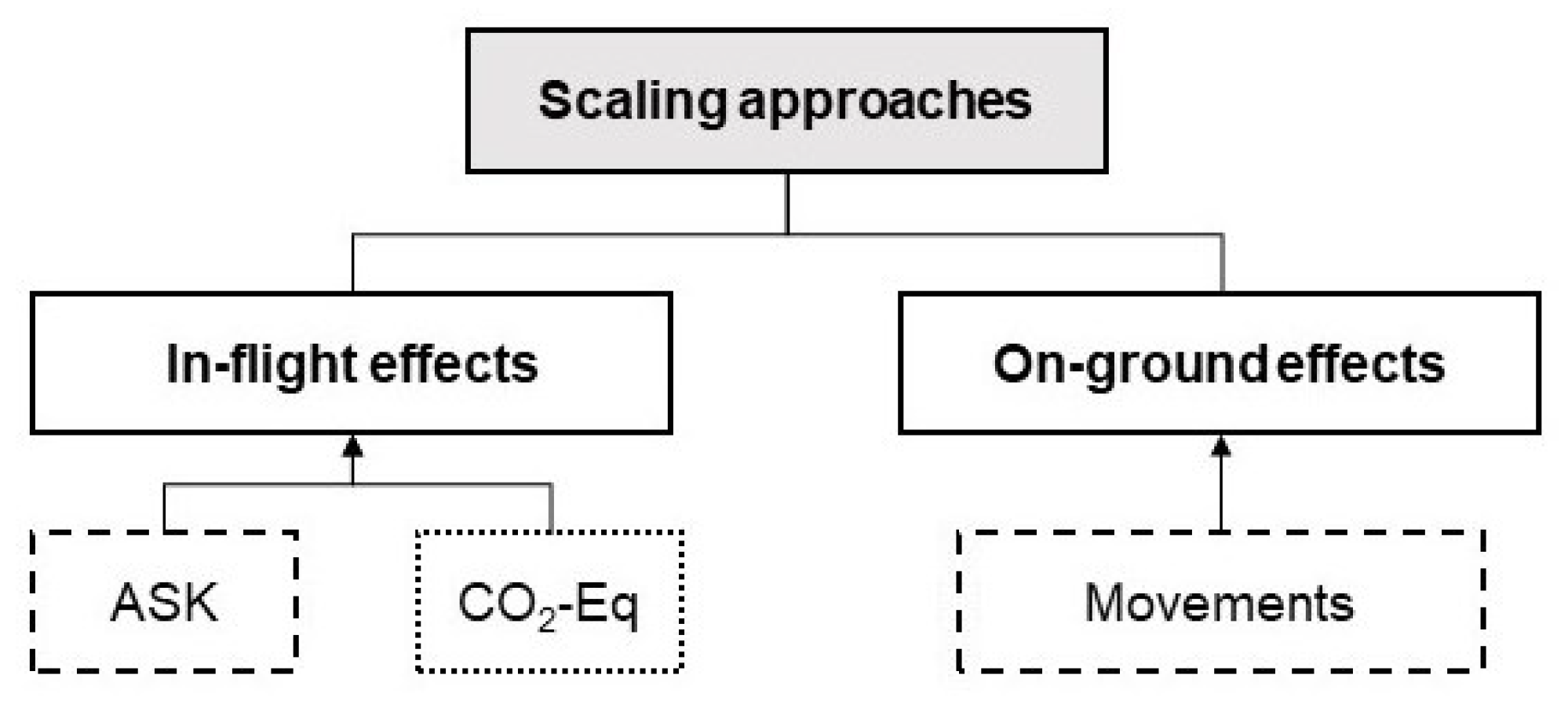


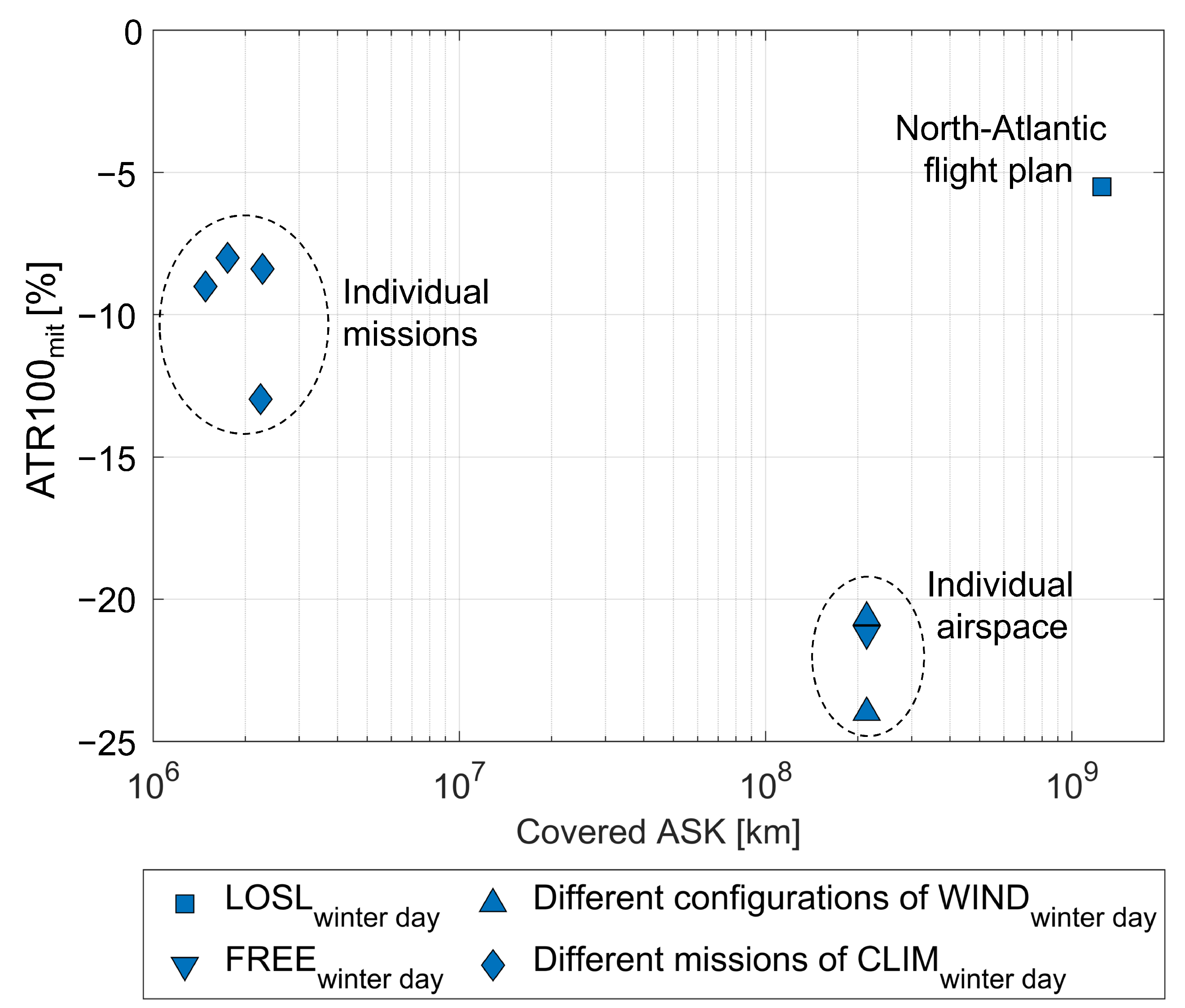
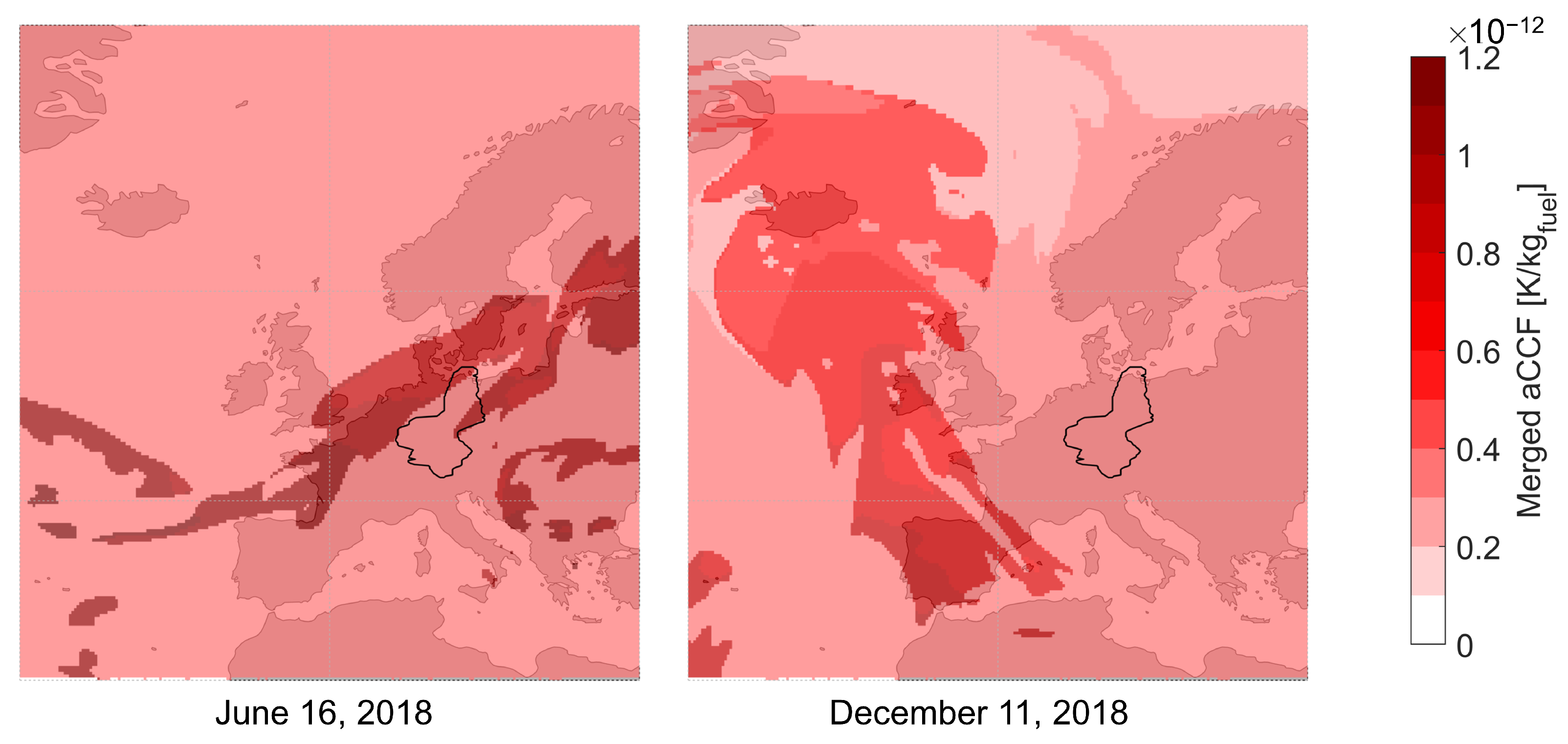
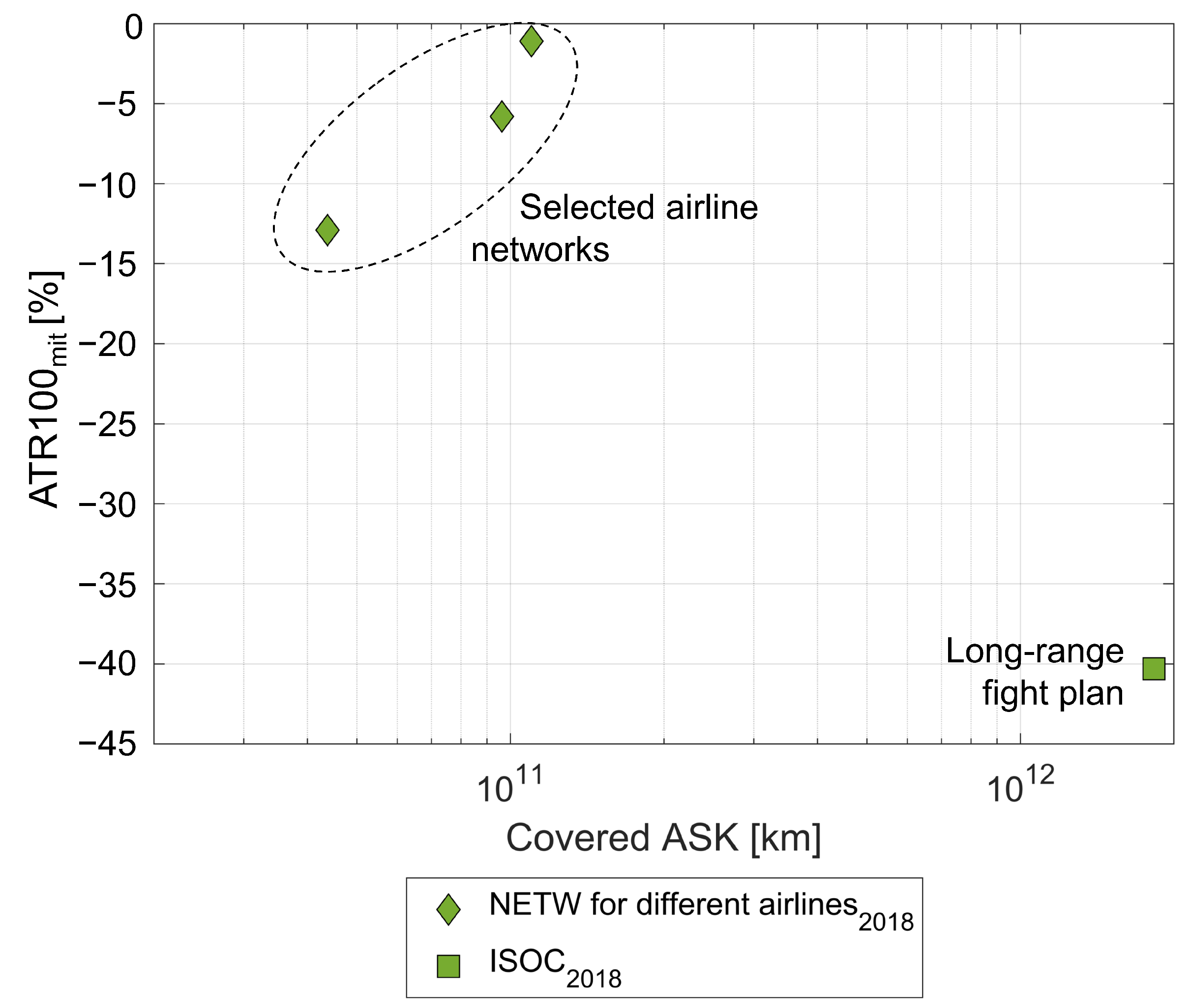
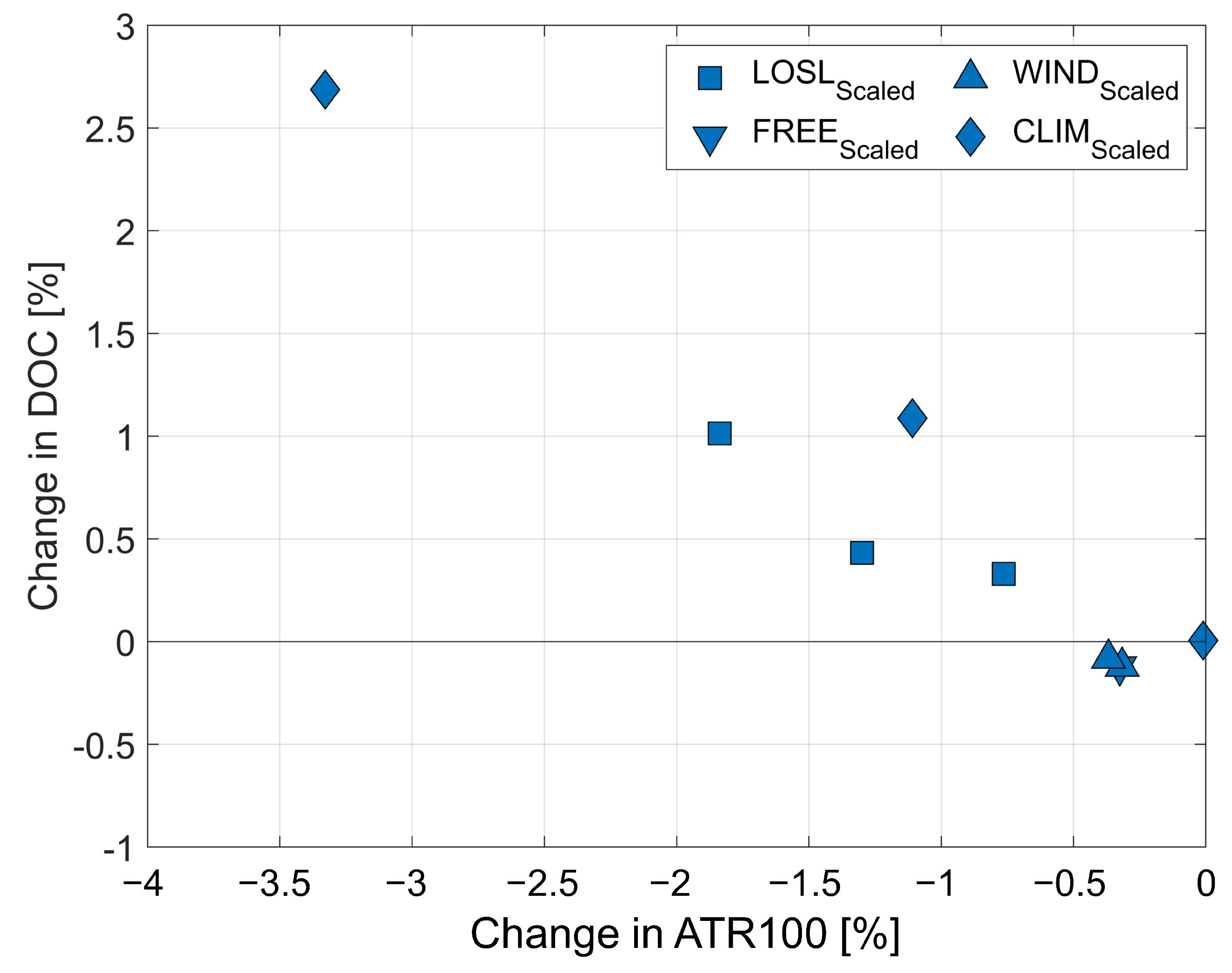


 ) to very low (
) to very low ( ) absolute climate mitigation potentials. Stakeholder impact is given as strongly negative (- - -), negative (- -), slightly negative (-), slightly positive (+), and positive (+ +).
) absolute climate mitigation potentials. Stakeholder impact is given as strongly negative (- - -), negative (- -), slightly negative (-), slightly positive (+), and positive (+ +).
 ) to very low (
) to very low ( ) absolute climate mitigation potentials. Stakeholder impact is given as strongly negative (- - -), negative (- -), slightly negative (-), slightly positive (+), and positive (+ +).
) absolute climate mitigation potentials. Stakeholder impact is given as strongly negative (- - -), negative (- -), slightly negative (-), slightly positive (+), and positive (+ +).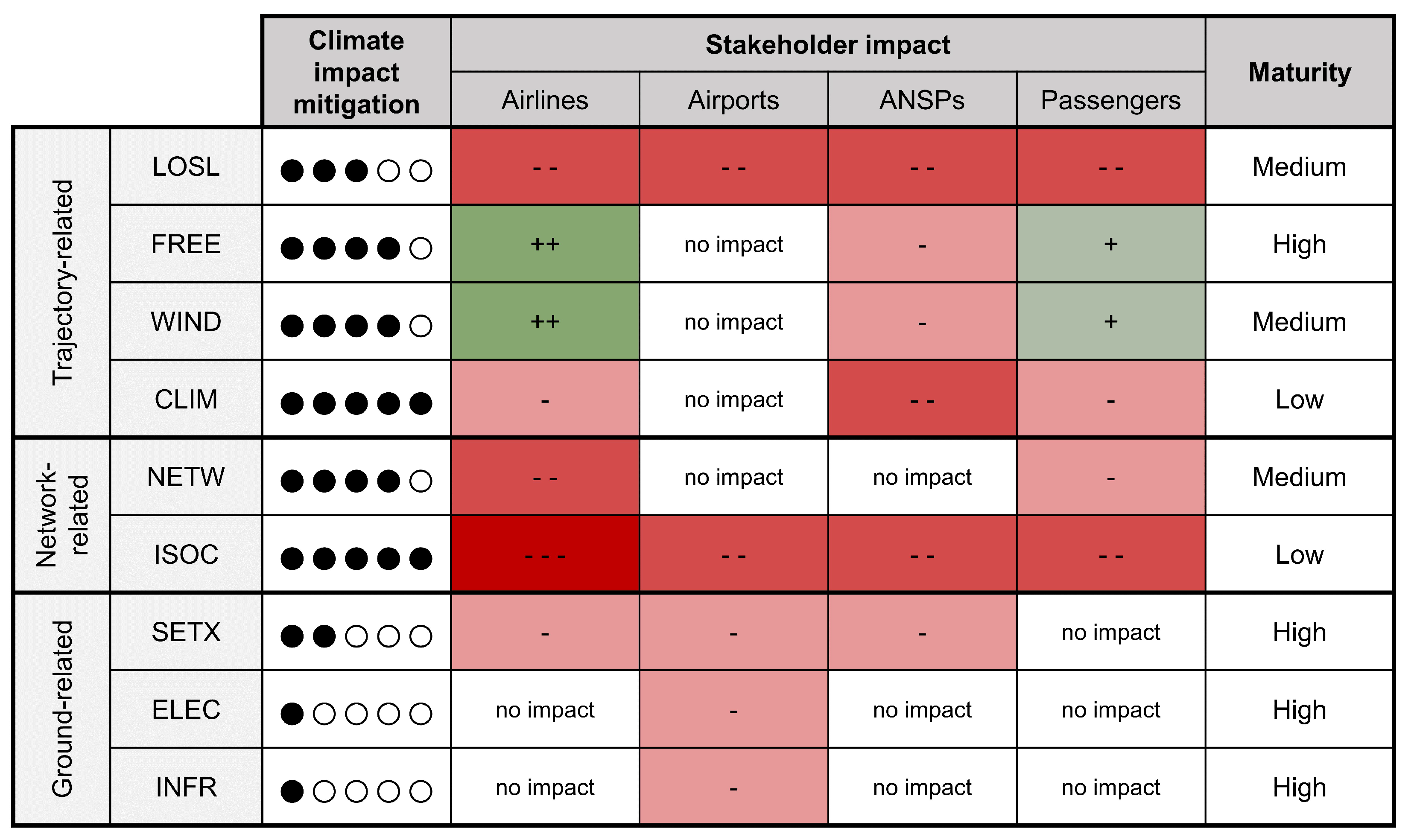
| In-Flight Measures | Ground-Related Measures | ||
|---|---|---|---|
| Trajectory-Related OIs | Network-Related OIs | ||
| Definition of OI type |
|
|
|
| Considered measures |
|
|
|
| Assessment | Individual trajectory optimization regarding CO and non-CO effects under specific weather conditions | Reduction in climate impact from CO and non-CO emissions for an extensive flight plans in a climatological approach | Reduction of carbon emissions and their respective climate impact on-ground |
| Reference publications | [45,46,47,48] | [20,31] | [49,50,51] |
| Properties | RF | GWP | GTP | ATR |
|---|---|---|---|---|
| Direct relation to | no | no | yes | yes |
| Accounts for lifetime | no | yes | yes | yes |
| Accounts for thermal inertia | no | no | yes | yes |
| Dependence on time horizon | strong | weak | strong | weak |
Disclaimer/Publisher’s Note: The statements, opinions and data contained in all publications are solely those of the individual author(s) and contributor(s) and not of MDPI and/or the editor(s). MDPI and/or the editor(s) disclaim responsibility for any injury to people or property resulting from any ideas, methods, instructions or products referred to in the content. |
© 2023 by the authors. Licensee MDPI, Basel, Switzerland. This article is an open access article distributed under the terms and conditions of the Creative Commons Attribution (CC BY) license (https://creativecommons.org/licenses/by/4.0/).
Share and Cite
Zengerling, Z.L.; Dal Gesso, S.; Linke, F.; Clococeanu, M.; Gollnick, V.; Peter, P.; Matthes, S.; Baspinar, B.; Ozkol, I.; Noorafza, M.; et al. Operational Improvements to Reduce the Climate Impact of Aviation—A Comparative Study from EU Project ClimOP. Appl. Sci. 2023, 13, 9083. https://doi.org/10.3390/app13169083
Zengerling ZL, Dal Gesso S, Linke F, Clococeanu M, Gollnick V, Peter P, Matthes S, Baspinar B, Ozkol I, Noorafza M, et al. Operational Improvements to Reduce the Climate Impact of Aviation—A Comparative Study from EU Project ClimOP. Applied Sciences. 2023; 13(16):9083. https://doi.org/10.3390/app13169083
Chicago/Turabian StyleZengerling, Zarah Lea, Sara Dal Gesso, Florian Linke, Maximilian Clococeanu, Volker Gollnick, Patrick Peter, Sigrun Matthes, Baris Baspinar, Ibrahim Ozkol, Mahdi Noorafza, and et al. 2023. "Operational Improvements to Reduce the Climate Impact of Aviation—A Comparative Study from EU Project ClimOP" Applied Sciences 13, no. 16: 9083. https://doi.org/10.3390/app13169083
APA StyleZengerling, Z. L., Dal Gesso, S., Linke, F., Clococeanu, M., Gollnick, V., Peter, P., Matthes, S., Baspinar, B., Ozkol, I., Noorafza, M., Roling, P., Branchini, E., Grampella, M., Abate, C., & Tedeschi, A. (2023). Operational Improvements to Reduce the Climate Impact of Aviation—A Comparative Study from EU Project ClimOP. Applied Sciences, 13(16), 9083. https://doi.org/10.3390/app13169083







